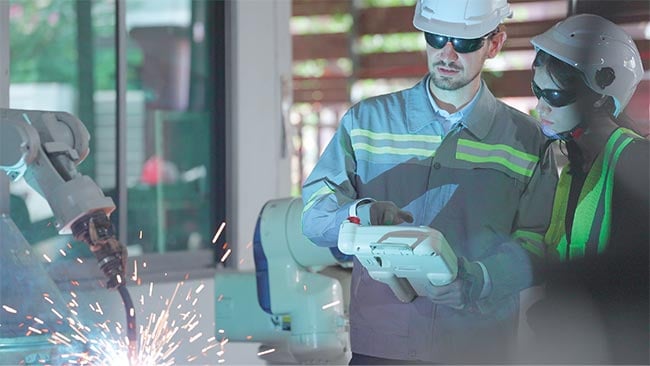KEN BARAT, LASER SAFETY SOLUTIONS
Many a researcher has probably shared, at one time or another, the wry sentiment, “Meetings: the practical
alternative to work.” I would argue that serving on your institution’s laser safety committee (LSC) does not involve meetings that fall into that category. Whether you are starting, rekindling, or joining your organization’s laser safety program, a functional, engaged committee is vital to its practical success. In the interest of transparency, it is worth noting that no laser standards require such a committee.
The most recent edition of the ANSI Z136.1 standard, Safe Use of Lasers (2022), only suggests that a committee be formed under certain circumstances. In Appendix A, under Section A2, titled “Laser Safety Committee,” it states that “A Laser Safety Committee may be
created as needed.” Not much of an
endorsement for such an important body.

Courtesy of iStock.com/MartinBarraud
Reading further, Section A2.1,
“Membership of Laser Safety Committee,” notes that the committee might comprise members with expertise in laser technology or the assessment of laser hazards. Management may also take part. Examples of members include, but are
not limited to, technical management,
the laser safety officer (LSO), and
representatives of the safety and industrial hygiene organization, physicians, education department members,
engineers or scientists, and user representatives.
The next section, A2.2, “Policies and Practices,” tasks the LSC with establishing and maintaining adequate policies
and practices for the evaluation and control of laser hazards, including recommendations for appropriate laser safety training programs and materials.
Lastly, Section A2.3, “Standards,” establishes that the committee shall
maintain an awareness of all applicable new or revised laser safety standards.
Even the latest edition (2018) of ANSI’s medical use standards, under Z136.3,
applies the word “should” to the question of whether an LSC should be formed.
Where a diversity of laser usage
warrants, such as in a large health care facility, an associated safety committee
or LSC “should” be formed to advise laser activity and enforce operational policies and procedures. The committee should
be multidisciplinary — its members including but not limited to the LSO,
risk management experts, laser users
and operators, biomedical engineers, medical and staff education managers, administration, allied health partners,
and anesthesiologists. The LSC should meet at least quarterly.
Types of laser safety committees
There are three types of LSCs: the one referenced in the standards that is made up of stakeholders; the second comprising membership of environmental, health, and safety staff; and the third that convenes around a specific task and, upon completion, sunsets itself.
Let’s review these in reverse order, starting with the task-specific committee. Many times, an issue arises that is either beyond the expertise of the LSO, that needs buy-in from the user community, or simply needs a more careful look at a certain practice — for example, how to determine the correct optical density for alignment eyewear for pulse systems. Maybe the issue is something that will have a large effect on the user population, such as the need to require a hands-on alignment course for all Class 3B and Class 4 laser users. Once the committee has investigated the issue, they prepare a decision or report and a policy is set. The committee then disbands. One advantage of this approach is that it is easier to attract members if they view an issue as important and understand that serving on the committee is not a life sentence. I can vouch this approach does work.
The second type of LSC, enlisting
safety division members, is often
employed when an institution has multiple divisions or sites, each with its own LSO or deputy LSO. The advantage of this approach is that it promotes consistent policy across the organization as well
as the sharing of common problems,
solutions, and best practices. The consistent and reasonable application of laser safety policies is critical to maintain a workable program. I have observed both sides of this approach. Those that are failing are easy to see. One recommendation is to foster good relations between the corporate/senior/lead LSO and all deputies. This approach is also important if international sites are part of the organization, and especially if the corporation desires a standard approach to its safety protocols. Companies that have international sites should read Chapter 13, written by Vince Staub, in the book Laser Safety: Practical Knowledge and Solutions.
The last type of LSC is a more traditional arrangement, and the most effective, which attracts members by letting them know that they have a chance to “write the rules.” Who could ask for more? Having a management representative on the committee is an ace in the hole. The hope is that the management representative will share the work and its challenges with upper management. Therefore, when the implementation of new practices requires funding or an action outside of the committee’s immediate domain, the beachhead has already been established with management. The committee will not need to explain from scratch what the problem and needs are.

Courtesy of iStock.com/kitiwanmesinsom
Another advantage of this type of committee is that it allows users who have a conflict with the LSO or with an institutional policy to present their case to their peers. On the flipside, this also allows the LSO to get support on actions against a user if, for example, they refuse to accept training. The LSO should never chair such a committee. They can set the agenda and act as the committee’s agent, but someone else needs to be its chairperson. A rotating chairperson — say, in a two-year rotation — is a good approach.
On a cautionary note, the committee needs to remember that it is the LSO that has the statutory responsibility for laser safety and will always need some degree of independence. An LSC that feels it needs to approve every standard operational procedure or safety design will only undercut the LSO and slow down progress. I have witnessed this. It is not effective or pretty.
A functional LSC is a valued asset in achieving and maintaining laser safety. It also looks very good to inspectors. By the way, serving lunch during the meeting is a must.